The Xperia Ion is the biggest handset in Sony’s line-up. It’s also the first one to have LTE support. Check out our full review of the Sony Xperia Ion after the break.
In a lot of ways, the Xperia Ion might look like the bigger sibling of the Xperia S but with a lot of similarities. We recommend you reading up on our review of the Sony Xperia S so you’ll know what we’re talking about.

The review unit that we have here is the L28i model which is LTE capable but since we still don’t ave any commercial LTE available in the Philippines, we can’t really test that one out. I recently talked to the PM of Sony Mobile and discussed the possibility of them releasing this model in the Philippines but we could not really get concerete details.
Design and Construction.
The Xperia Ion is big and bold, even heavyset for its size. Those metal plates at the back might have contributed to that. The handset has a metal and polycarbonate unibody design with flat front panel, wedged corners and curved back just like the other NXT line.
The are a lot of visible buttons and ports in here — a large 3.5mm audio jack is smack in the center of the topside, the power button is on the right side along with the volume rocker and the dedicated camera button.

On the left side, the micro-USB port and the micro-HDMI ports are hidden by a flip cover. At the back is the 12-megapixel camera with the LED flash just below it along with the speaker grills.
The top end has is a plastic cap which can be removed by sliding to expose the slots for the micro-SIM card and the micro-SD card.
Up at front is a large sheet of glass that covers the entire front panel. There are four soft buttons at the botom end — Back, Home, Menu and Search — and a large Xperia logo just below it.

Sony still uses that NXT design signature that’s monolithic and a bit bulky. In fact, it’s the only flagship handset we’ve seen that’s not under 10mm thin (this one is 10.8mm). Nevertheless, the industrial look, brushed-metal finish and solid build is what differentiates it from the rest of the pack.
Display.
The large 4.6-inch display comes with a 720p HD Reality Display that we’ve been seeing since the Xperia Arc days, right up to the new Xperia line-up.
The screen is a bright and crisp as the one on the Xperia S, with rich vivid colors and just the right amount of color saturation. With a 720×1280-pixel resolution, you get a really packed screen with a pixel density of 323ppi.
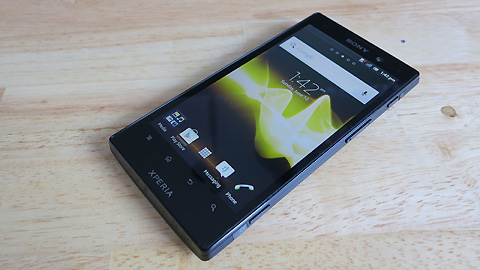
Outdoor visibility is greatly affected, especially under direct sunlight but that’s pretty much expected. You can still use it if you have the brightness cranked up to the highest setting.
The Mobile Bravia Engine helps a bit when viewing photos and videos stored in the Gallery but I don’t notice its effect when using the browser or playing games.
OS and UI.
The handset comes pre-installed with Android 2.3.7 Gingerbread. It would have been nice if they already used ICS on this one but at the rate we’re seeing, the Xperia Ion might take a few more months to get the update (the Xperia S which was released in February has started getting ICS this month so that’s a 4-month delay).
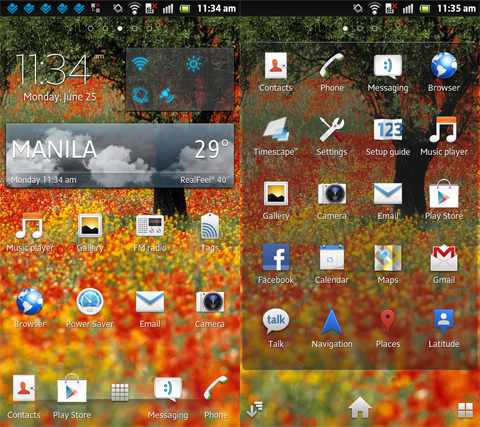
Sony’s Timescape UI is among the nicest UI skinned on top of an Android OS. There aren’t a lot of native widgets but the ones that are available are pretty neatly done.
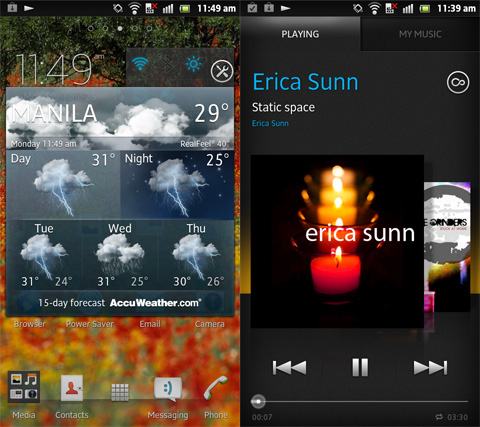
We loved the PlayOn feature that’s integrated into the menu so you can thrown multimedia content (music, video, photos) to another Sony device (like a Vaio or a Bravia TV) wirelessly.
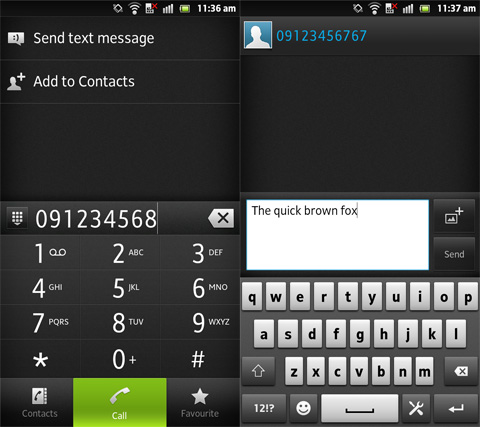
The native Xperia virtual keyboard is simple and easy to use. The keys are large enough and well-spaced from each other.
Multimedia and Camera.
After using the camera on the Xperia S and the mid-range Xperia P, we had high expectations with the 12-megapixel shooter of the Xperia Ion.
Unfortunately, we were a bit disappointed. While photo quality looked good, it’s not any better than the Xperia S or Xperia P. In fact, based on the samples we’ve taken, the Xperia P photos we took turned out better than the Xperia Ion.
[fancygallery ID=”xperiaionphotos”]
We noticed that while the Xperia S does really well on low-light conditions, the Xperia Ion did not match that capability.
The Ion can capture 1080p video at 30fps but seems like there are a lot of dropped frames in our sample video here.
One of the great features that come will all Xperia camera is their ability to take panoramic photos in a single swipe and even do 3D photos but that one looks a little gimmicky. It’s still usable but we’d rather recommend using a headphone with it.
The speaker at the back is actually loud but it wasn’t as crisp as we expected it to be (it seems to lack enough bass for our taste).
Performance and Benchmarks.
The Xperia Ion pretty much performs just as good as the Xperia S. In fact, our benchmark scores for all three tests — Quadrant Standard, Antutu and Nenamark 2 — turned out almost exactly the same on the Xperia Ion and the Xperia S.
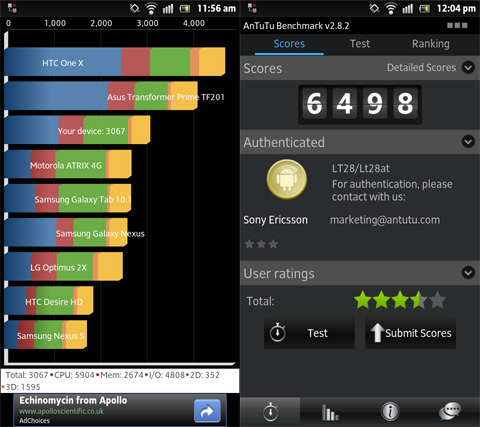
Results for Quadrant Standard puts the Xperia Ion somewhere in the upper middle class with a score of 3067. The Antutu Benchmark score puts it above most other dual-core smartphones at 6498.
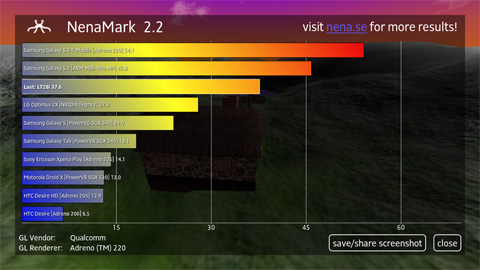
Nenamark 2 benchmark shows performance of the graphics and a score of 37.6fps isn’t bad at all.
Note that the Xperia Ion shares the same SnapDragon S3 processor as the Xperia S so the results of the benchmarks are the same.
Call Quality and Battery Life.
We initially thought the back metal plating might affect the cell signal strength but from our numerous test, we have not experienced any dropped calls. It could be the reason why the top and bottom cap at the back is made of plastic instead of the same sheet of metal.
Voice quality is good and WiFi signal is strong and comparable to other handsets with a plastic back panel, like the Xperia S.
As for battery life, we were surprised to see the Xperia Ion lasts about 2 days of moderate use. The 1900mAh Li-Ion battery certainly delivers and the fact that we couldn’t use the LTE network helped reduced the drain. We wonder though what the battery life would be if we had LTE running on this handset.
Conclusion.
The Xperia Ion represents the best what Sony can offer to its customer but in the world where quad-core processors are the new craze, the Xperia Ion might be considered a handset of the previous generation.
One of its major selling point is the LTE capability but sadly that may not mean anything here in the Philippines since there’s no service yet to speak of. This issue is more of infrastructure rather than the handset itself.

We could not see any compelling reason for the Xperia Ion aside from the larger display. Of course, had there been an LTE service that we could subscribe and use, our verdict might have been different. But until then, the Xperia Ion is just a bigger and heavier version of the Xperia S.
Sony Xperia Ion LTE LT28i specs:
4.6-inch HD Reality Display @ 720×1280 pixels, 323ppi
Sony Mobile BRAVIA Engine
Qualcomm MSM8260 Snapdragon S3 1.5GHz dual-core
Adreno 220 graphics
1GB RAM
16GB internal storage
up to 32GB via microSD card
HSDPA 21.1Mbps, HSUPA 5.8Mbps, LTE Cat3 50Mbps
WiFi 802.11 b/g/n
Bluetooth 2.1
NFC
FM Radio tuner
12MP autofocus, rear camera w/ LED flash
1080p video recording @ 30fps
1.3MP front-facing camera w/ 720 video recording 30fps
Android 2.3 Gingerbread
1900mAh Li-Ion battery
144 grams (weight)
133 x 68 x 10.8mm (dimensions)
Php24,900USD 424INR 35,971EUR 404CNY 3,090 (gray market price)
What we liked about it:
* Solid design and metal construction
* NFC support
* Above average performance
* LTE support
* Good battery life
What we did not like:
* Still a little thick
* Did not match the Xperia S and Xperia P camera performance
* No ICS out of the box

YugaTech.com is the largest and longest-running technology site in the Philippines. Originally established in October 2002, the site was transformed into a full-fledged technology platform in 2005.
How to transfer, withdraw money from PayPal to GCash
Prices of Starlink satellite in the Philippines
Install Google GBox to Huawei smartphones
Pag-IBIG MP2 online application
How to check PhilHealth contributions online
How to find your SIM card serial number
Globe, PLDT, Converge, Sky: Unli fiber internet plans compared
10 biggest games in the Google Play Store
LTO periodic medical exam for 10-year licenses
Netflix codes to unlock hidden TV shows, movies
Apple, Asus, Cherry Mobile, Huawei, LG, Nokia, Oppo, Samsung, Sony, Vivo, Xiaomi, Lenovo, Infinix Mobile, Pocophone, Honor, iPhone, OnePlus, Tecno, Realme, HTC, Gionee, Kata, IQ00, Redmi, Razer, CloudFone, Motorola, Panasonic, TCL, Wiko
Best Android smartphones between PHP 20,000 - 25,000
Smartphones under PHP 10,000 in the Philippines
Smartphones under PHP 12K Philippines
Best smartphones for kids under PHP 7,000
Smartphones under PHP 15,000 in the Philippines
Best Android smartphones between PHP 15,000 - 20,000
Smartphones under PHP 20,000 in the Philippines
Most affordable 5G phones in the Philippines under PHP 20K
5G smartphones in the Philippines under PHP 16K
Smartphone pricelist Philippines 2024
Smartphone pricelist Philippines 2023
Smartphone pricelist Philippines 2022
Smartphone pricelist Philippines 2021
Smartphone pricelist Philippines 2020
Jam says:
Just the review I’ve been waiting for so long. Thank you so much Sir Yuga. :))
Sucks says:
Sucks
Guest says:
Sir, hindi irerelease ng Sony Mobile yang LTE version dito. Xperia ion HSPA ang global version nila. Kaya malabo na LTE version yan pag official launch na. At saka ics na siya pag na release. Check niyo to sa cnet. Event recently lang sa Singapore.
http://asia.cnet.com/sony-showcases-six-new-handsets-in-asia-62216818.htm
Zo says:
but Philippines wasn’t mentioned. :|
I don’t want to assume that Singapore release date will be same as ours :|
thanks for the info still.
aladin says:
is this model be available in the philippines?
martiankid says:
I dont get it. You just said that 3D camera is “still usable but we’d rather recommend using a headphone with it.”
I am ME says:
you’re not impressed by the photos taken from the ion cam…but for me its way much better compare to any nokia or samsung
the 3 megapixel camera of sony phones captures much better pictures compare to 5 megapixel cameras of nokia and samsung
USER says:
using an ion. . .
still no ICS update and may LTE xa. ..
bought it sa Xperia Store.. . .
so i guess LTE version po andito sa pinas.. . ????
Boy says:
Sir supported naba yan ng Skype video call.thanks
Red says:
Xperia Sola or Ion?
rowne says:
I have my lt28i here In the philippines… Recently updated to jellybean
ecz says:
Hello anyone here who knows why the front camera of ion, when turned on in skype it won’t caught in screenshot? And actually turns black.